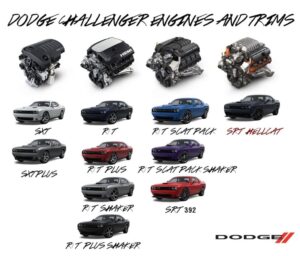Don’t miss out on your last chance to experience the power and performance of the legendary Hemi engine. Rev up your engines and head over to https://buyfromnorm.ca to get your hands on this iconic piece of automotive history. Don’t wait, this is truly the end of an era. Click here to take advantage of this opportunity before it’s too late!
The Evolution of Muscle Cars: A Look at the End of the Hemi Engine Era

For decades, the Hemi engine has been synonymous with power, speed, and the iconic muscle cars of the past. From the classic Dodge Charger to the legendary Plymouth Barracuda, the Hemi engine has been a staple in the automotive industry, setting records and winning races. However, as we enter a new era of electric and hybrid vehicles, the end of the Hemi engine era is upon us. But before we say goodbye, let’s take a look at the evolution of muscle cars and the impact of the Hemi engine.
The Hemi engine, short for hemispherical combustion chamber, was first introduced by Chrysler in the 1950s. Its unique design allowed for better air and fuel flow, resulting in increased power and performance. This engine quickly gained popularity among car enthusiasts and became a dominant force in the racing world. In fact, the Hemi engine was so powerful that it was banned from NASCAR races in the 1960s.
In the 1960s and 1970s, muscle cars were at the height of their popularity, and the Hemi engine was at the forefront. The Dodge Charger, Plymouth Road Runner, and the iconic Plymouth Barracuda were just a few of the muscle cars that featured the Hemi engine. These cars were not only known for their speed and power but also for their sleek and aggressive designs. They were a symbol of American muscle and a reflection of the era’s rebellious and free-spirited culture.
As the years went by, the Hemi engine continued to evolve and improve. In the 2000s, Chrysler introduced the modern Hemi engine, which featured advanced technology such as variable valve timing and cylinder deactivation. This allowed for better fuel efficiency without compromising on power. The modern Hemi engine was used in popular models like the Dodge Challenger and the Chrysler 300, keeping the legacy of the Hemi engine alive.
However, with the rise of electric and hybrid vehicles, the demand for powerful and fuel-efficient engines has shifted. As a result, many car manufacturers, including Chrysler, have announced their plans to phase out the Hemi engine. This marks the end of an era for muscle cars and the iconic Hemi engine.
But why is the Hemi engine being phased out? The answer lies in the ever-changing landscape of the automotive industry. With stricter emissions regulations and the push towards more environmentally friendly vehicles, car manufacturers are shifting their focus towards electric and hybrid technology. These vehicles offer high performance and efficiency without the need for a traditional combustion engine.
While the end of the Hemi engine era may be bittersweet for some, it also marks the beginning of a new chapter in the automotive world. Electric and hybrid vehicles are becoming more mainstream, and car manufacturers are investing heavily in their development. This means that we can expect to see even more powerful and efficient vehicles in the future.
In conclusion, the Hemi engine has played a significant role in the evolution of muscle cars and the automotive industry as a whole. Its power and performance have left a lasting impact and will be remembered by car enthusiasts for years to come. As we bid farewell to the Hemi engine, let’s look forward to the future of electric and hybrid vehicles and the exciting possibilities they hold. So, if you’ve always dreamed of owning a muscle car with a Hemi engine, now is your last chance to rev up and experience the thrill of this legendary engine.
Saying Goodbye to a Legend: The Last Models with the Hemi Engine

As car enthusiasts, we all have our favorite engines that we hold near and dear to our hearts. For many of us, the Hemi engine is one of those iconic powerhouses that has been a staple in the automotive industry for decades. However, as we enter a new era of technology and efficiency, it’s time to bid farewell to this legendary engine. The last models with the Hemi engine are hitting the market, and it’s your last chance to rev up with this iconic piece of machinery.
The Hemi engine, short for hemispherical combustion chamber, was first introduced by Chrysler in the 1950s. Its unique design allowed for better air and fuel flow, resulting in increased power and performance. This engine quickly gained popularity and became a symbol of American muscle cars. From the classic Dodge Charger to the powerful Plymouth Barracuda, the Hemi engine was a key component in some of the most iconic and beloved cars in history.
Over the years, the Hemi engine has undergone many changes and improvements, but its distinct sound and power have remained constant. However, with the rise of electric and hybrid vehicles, the demand for fuel-efficient engines has increased, and the Hemi engine has become a casualty of this shift. As a result, the last models with the Hemi engine are being produced, marking the end of an era for this iconic engine.
One of the last models to feature the Hemi engine is the 2021 Dodge Durango SRT Hellcat. This SUV boasts a massive 6.2-liter supercharged Hemi V8 engine, producing a whopping 710 horsepower. It’s the most powerful SUV ever made, and it’s a fitting tribute to the Hemi engine’s legacy. The Durango SRT Hellcat is a true testament to the Hemi engine’s power and performance, and it’s a must-have for any car enthusiast looking to experience this legendary engine one last time.
Another model bidding farewell to the Hemi engine is the 2021 Ram 1500 TRX. This pickup truck is a beast on and off the road, thanks to its 6.2-liter supercharged Hemi V8 engine, producing 702 horsepower. It’s the most powerful production pickup truck ever made, and it’s a testament to the Hemi engine’s versatility. Whether you’re hauling heavy loads or conquering rough terrain, the Ram 1500 TRX with the Hemi engine is up for the challenge.
But it’s not just about power and performance; the Hemi engine has also left its mark on the racing world. The 2021 Dodge Challenger Drag Pak is the last model to feature the Hemi engine, and it’s a fitting farewell to this iconic engine’s racing legacy. This drag racing machine is equipped with a 354-cubic-inch supercharged Hemi V8 engine, producing over 1,000 horsepower. It’s a true testament to the Hemi engine’s durability and ability to withstand extreme conditions.
As we say goodbye to the Hemi engine, it’s important to remember its impact on the automotive industry. It’s not just an engine; it’s a symbol of American muscle and a reminder of a bygone era. The last models with the Hemi engine are a collector’s dream, and they will surely hold a special place in the hearts of car enthusiasts for years to come.
In conclusion, the end of an era is upon us, and it’s time to bid farewell to the legendary Hemi engine. The last models with this iconic engine are hitting the market, and it’s your last chance to experience its power and performance. Whether you’re a fan of muscle cars, pickup trucks, or drag racing, there’s a model with the Hemi engine that will satisfy your need for speed. So don’t miss out on this opportunity to rev up with the Hemi engine one last time before it becomes a thing of the past.
From Gas Guzzlers to Electric Power: The Future of Muscle Cars without the Hemi Engine

For decades, the Hemi engine has been a staple in the world of muscle cars. Its powerful and iconic design has made it a fan favorite among car enthusiasts. However, with the rise of electric cars and stricter emissions regulations, the future of muscle cars without the Hemi engine is uncertain. As we bid farewell to this legendary engine, let’s take a look at how the automotive industry is shifting towards a more eco-friendly future.
The Hemi engine, short for hemispherical combustion engine, was first introduced by Chrysler in the 1950s. Its unique design, with hemispherical combustion chambers and two valves per cylinder, allowed for better air and fuel flow, resulting in increased power and performance. This made it a popular choice for muscle cars, which were known for their speed and strength.
Over the years, the Hemi engine has undergone several improvements and variations, with the most recent being the 6.2-liter supercharged Hemi V8 found in the Dodge Challenger and Charger Hellcat models. This engine produces a whopping 717 horsepower, making it one of the most powerful engines on the market. However, with the increasing concern for the environment and the push towards electric vehicles, the days of the Hemi engine may be numbered.
One of the main reasons for the decline of the Hemi engine is the stricter emissions regulations imposed by governments around the world. As these regulations become more stringent, car manufacturers are forced to find ways to reduce emissions and increase fuel efficiency. This has led to the development of hybrid and electric cars, which are seen as a more sustainable alternative to traditional gasoline-powered vehicles.
In fact, many car companies have already announced plans to shift towards electric vehicles in the coming years. Ford, for example, has pledged to invest $11 billion in electric and hybrid cars by 2022. General Motors has also announced that they will have 20 electric models in their lineup by 2023. With these major players in the industry making the switch, it’s clear that the future of cars is electric.
But what does this mean for muscle cars? Without the Hemi engine, will they lose their power and performance? The answer is no. In fact, electric cars have proven to be just as, if not more, powerful than their gasoline counterparts. Take the Tesla Model S, for example. This all-electric sedan can go from 0 to 60 mph in just 2.3 seconds, making it one of the fastest production cars in the world. And with advancements in battery technology, electric cars are only going to get faster and more powerful.
However, the shift towards electric cars also means saying goodbye to the iconic sound of the Hemi engine. The roar of a muscle car’s engine has always been a defining characteristic, but with electric cars, there is no engine noise. This may be a disappointment for some die-hard muscle car fans, but it’s a small price to pay for a cleaner and more sustainable future.
In conclusion, the end of the Hemi engine marks the end of an era in the world of muscle cars. While it may be sad to see it go, the shift towards electric vehicles is a necessary step towards a more environmentally friendly future. And who knows, maybe one day we’ll see an electric muscle car with the same power and performance as the legendary Hemi engine. Until then, let’s enjoy the last few years of revving up with this iconic engine.




